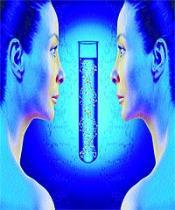Reproductive Cloning Basic Science

Reproductive cloning means creating a genetic duplicate of an existing organism. A human clone would be a genetic duplicate of an existing person.
Genes are strings of chemicals that help create the proteins that make up your body. Genes are found in long coiled chains called chromosomes. They are located in the nuclei of the cells in your body.

In sexual reproduction, a child gets half its genes from its mother (in her egg) and half from its father (in his sperm):

This combination of genes is a fundamental basis for human variation and diversity.
In the case of clonal reproduction, all of the cloned child's genes would come from a body cell of a single individual:

The best known cloning technique, somatic cell nuclear transfer (SCNT), is shown above. The nucleus from a body cell is put into an egg from which the nucleus has been removed. The resulting entity is triggered by chemicals or electricity to begin developing into an embryo. If that embryo were placed into a woman's uterus and brought to term, it would develop into a child that would be the genetic duplicate of the person from whom the original body cell nucleus was taken—a clone.
Parthenogenesis, an alternate cloning technique, is shown below. An egg, with a full set of 46 chromosomes, is chemically or electrically induced to begin dividing and differentiating.

(Images courtesy of the Association of Reproductive Health Professionals)
New techniques, such as the derivation of induced pluripotent stem cells via cellular reprogramming, suggest other potential methods of reproductive cloning.
Page last modified March 10, 2010



